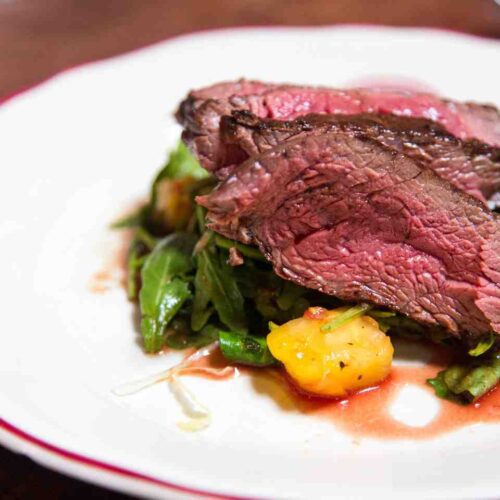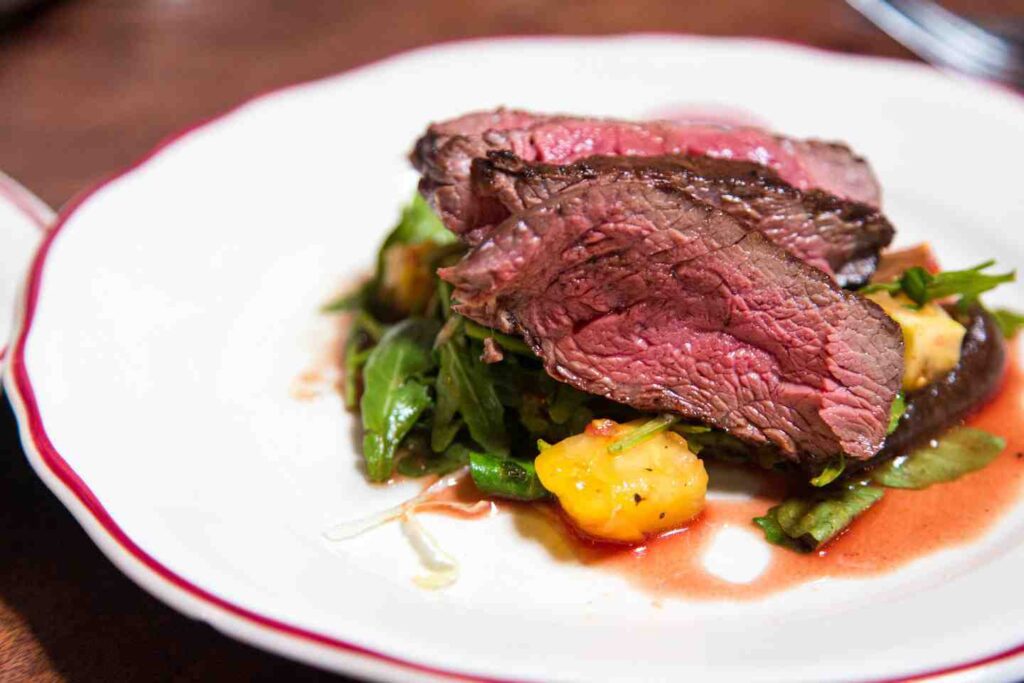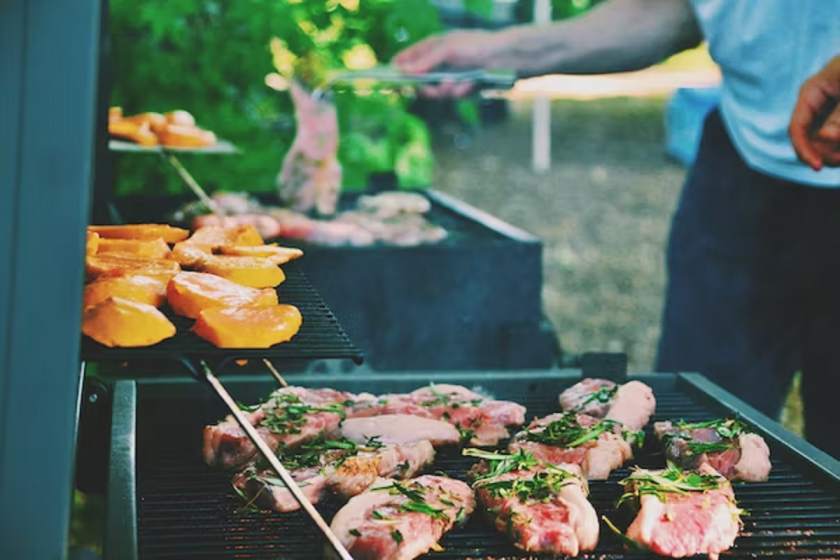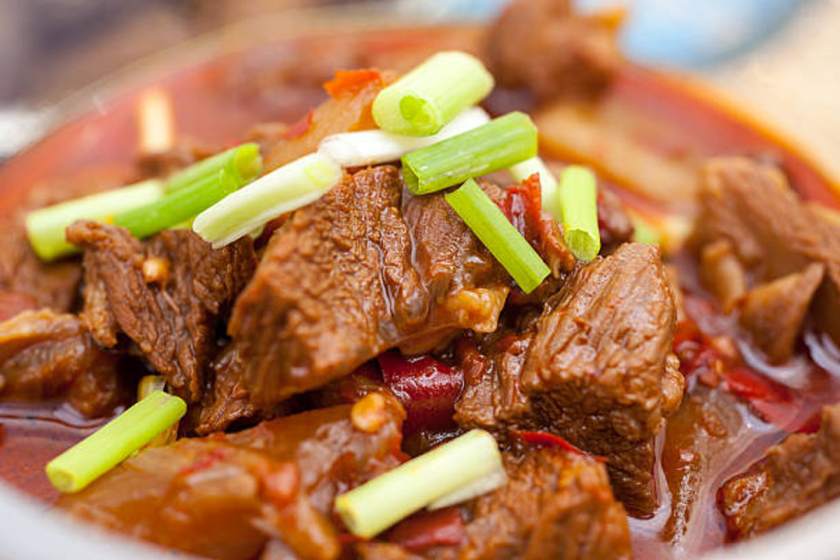Braising is a culinary technique that transforms modest, tougher cuts of meat into delectable dishes that are denoted by their melt-in-your-mouth texture. This method entails the gradual cooking of meat in a liquid that is rich in flavor, resulting in tender and succulent outcomes. It is a process that demands patience, but the end result is a depth of flavor that is unmatched. Whether you are an experienced chef or a home cook, mastering the art of Braising can elevate your culinary skills to new heights.

Braising Steak
Equipment
- 1 Dutch Oven or Braising Pan: A heavy-bottomed pot with a tight-fitting lid is essential for braising. It helps distribute heat evenly and retains moisture during the cooking process.
- 1 Tongs These are useful for flipping and handling the steak without piercing it, which helps retain its juices.
- 1 Knife A sharp chef's knife for trimming excess fat and preparing any vegetables or aromatics
- 1 Cutting Board Use a large cutting board to prep your ingredients.
Ingredients
- 2 pounds beef steak (such as chuck, round, or brisket)
- 1 tbsp vegetable oil 2 tablespoons vegetable oil
- 1 cup red wine 1 cup red wine (such as merlot or cabernet sauvignon)
Instructions
- Prepare the Steak: Begin by patting the steak dry with paper towels. This helps ensure a good sear.
- Season the Steak: Generously season both sides of the steak with salt and freshly ground black pepper.
- Sear the Steak: In a large, heavy-bottomed pot or Dutch oven, heat the vegetable oil over medium-high heat.
Video
Notes
Table of contents
- What is Braising Steak?
- How to cook Braising Steak?
- Benefits of Braising Tougher Cuts
- History and Significance
- Slow-Cooked Beef: A Savory Delight for Your Taste Buds
- Related Posts
What is Braising Steak?
The culinary technique of braising steak is known for its ability to convert tough cuts of meat into tender and tasty treats. This method entails the initial searing of the meat to achieve a caramelized crust, followed by a gentle simmering in a liquid, such as broth, wine, or a combination of both. The gradual cooking process actually breaks down the collagen in the meat, resulting in a delicious melt-in-your-mouth texture that is both enjoyable and kind.
How to cook Braising Steak?
To cook Braising Steak, start by seasoning the braising gammon steak with salt and pepper, then sear it in a hot skillet with oil until browned. Remove the steaks and sauté onions, carrots, and garlic until softened. Add tomato paste, broth, and herbs; bring to a simmer. Return the steaks to the skillet, cover, and let them cook on low heat until tender, around 2-3 hours. The slow simmering process will result in a flavorful and tender braised steak.
- How to cook Braising Steak in the oven?
To cook Braised Steak in the oven, preheat to 325°F (160°C). Season and sear the steak in an oven-safe pan. Add broth, wine, or sauce, cover tightly, and bake for 2-3 hours until tender. Check for doneness and serve with the reduced cooking liquid.
- How to cook Braising Steak in a slow cooker?
To cook Braised Steak in a slow cooker, sear the seasoned steak in a pan, then transfer to the slow cooker. Add onions, carrots, garlic, and your choice of broth or wine. Cook on low for 6-8 hours until the meat is tender. Serve with the rich, delicious sauce from the slow cooker.
- How to cook Braising steak quickly?
For a quicker Braised Steak, sear seasoned steaks, set aside. Sauté onions, carrots, and garlic. Add tomato paste, broth, herbs, return steaks, and simmer covered on low for 45 minutes to an hour for tender, flavorful results.
Benefits of Braising Tougher Cuts
Braising is not solely intended to render meat tender, but rather to imbue it with a group of flavors. This technique is particularly good for tougher cuts of meat, which are frequently more thrifty. The gradual cooking process spoils connective tissues, yielding juicy meat that is replete with savory nuances. Furthermore, the braising liquid changes into a savory potion that can be packed into pleasing sauces. This approach is a mutually healthy solution for both culinary lovers who prioritize taste and those who are budget-conscious.
History and Significance
The culinary technique of braising has a rich historical background that can be traced back to ancient cultures. Initially, it was developed as a means of rendering tougher cuts of meat more edible. As time progressed, it evolved into a highly respected cooking method, renowned for its capacity to produce hearty and comforting dishes. From traditional European stews to exquisite Asian braised treats, this technique has become a staple in kitchens worldwide.
Key Ingredients for braising steak
To achieve the utmost flavor and tenderness in your braised steak, it’s crucial to select the right ingredients. Here’s what you’ll need:
Ingredients:
- 2 pounds (about 900g) beef steak (such as chuck or round), cut into serving-sized pieces
- 2 tablespoons vegetable oil
- 1 onion, chopped
- 2 carrots, peeled and sliced
- 2 celery stalks, chopped
- 3 cloves garlic, minced
- 2 cups beef broth
- 1 cup red wine (optional)
- 2 tablespoons tomato paste
- 1 teaspoon dried thyme
- 1 teaspoon dried rosemary
- Salt and pepper to taste
- Chopped fresh parsley, for garnish
- Quality Cut of Beef: Begin with a well-marbled, boneless beef cut such as a chuck, short ribs, or brisket. Around 1.5 to 2 pounds of meat should suffice for 4 servings.
- Aromatic Vegetables: Onions, carrots, and celery are essential aromatic vegetables that will enhance the flavor of your dish. Roughly chop 1 onion, 2 carrots, and 2 celery stalks.
- Broth or Wine: Opt for a rich beef broth or red wine to provide depth to your braising liquid. Approximately 2 cups will be needed.
- Flavorful Herbs and Spices: Bay leaves, thyme, rosemary, and crushed garlic cloves will infuse your braised steak with delightful aromas.
- Salt and Pepper: Season your meat and vegetables to perfection.
Step-by-Step Instructions
- Seasoning the Meat: Begin by generously seasoning your beef cut with salt and pepper. This step sweetensthe meat’s natural flavors.
- Searing the Meat: Heat a heavy-bottomed pan or Dutch oven over medium-high heat. Add a splash of oil and sear the meat on all sides until a deep brown crust forms. Remove the meat and set it aside.
- Sautéing Aromatics: In the same pan, sauté the chopped onions, carrots, and celery until they soften and develop a golden hue.
- Deglazing: Pour in your chosen liquid, whether it’s beef broth or red wine. Use a wooden spoon to scrape up the flavorful browned bits from the bottom of the pan.
- Adding Herbs and Spices: Drop in the bay leaves, thyme, rosemary, and crushed garlic cloves. These herbs will infuse the braising liquid and meat with a heavenly aroma.
- Returning the Meat: Gently place the seared meat back into the pan, providing it’s partially submerged in the braising liquid.
- Braising: Lower the heat to a gentle simmer. Cover the pan with a lid and let the meat braise for 2 to 3 hours, or until it becomes tender and easily pulls apart with a fork.
- Final Seasoning: Taste the braising liquid and adjust the seasoning with salt and pepper as needed.
Per Serve Cost Breakdown
Now, let’s break down the per serve cost of this delectable dish:
- Quality Beef Cut: $10-$15 (approx.)
- Aromatic Vegetables: $2-$3 (approx.)
- Broth or Wine: $1-$2 (approx.)
- Herbs and Spices: $1 (approx.)
- Salt and Pepper: Negligible
- Total: $14-$21 (approx.)

Slow-Cooked Beef: A Savory Delight for Your Taste Buds
When it comes to savoring the rich flavors of juicy meat, slow-cooked beef emerges as the agreed star. This culinary method has withstood the test of time, delivering tender and delectable products that leave gourmets craving for more. In this article, we shall delve into the realm of slow-cooked beef, examining its advantages, optimal techniques, and a selection of fun recipes that are sure to tantalize your palate.
Mastering the Slow-Cooking Technique
Choosing the Right Cut of Beef
For the ultimate slow-cooked beef experience, the choice of meat is crucial. Opt for tougher cuts like chuck, brisket, or shank, as these have more connective tissues that will render beautifully during the slow cooking process.
Searing for Flavor: To Do or Not To Do?
While it’s common to sear meat before slow cooking, opinions differ on its necessity. Searing can add an extra layer of flavor by creating a Maillard reaction, but skipping this step can lead to a more delicate beef taste. Experiment with both methods to find your preference.
Setting the Stage with Aromatics
Aromatics like onions, garlic, and herbs are essential to infuse the beef with captivating flavors. These ingredients complement the meat’s richness and add depth to the overall taste profile.
Delectable Slow-Cooked Beef Recipes
Classic Beef Stew
Indulge in the ultimate comfort food with a hearty beef stew. Cubes of beef are simmered alongside an assortment of vegetables in a savory broth, resulting in a bowl of warmth and satisfaction.
Braised Beef Tacos
Elevate your taco game with braised beef tacos. Tender, shredded beef is nestled in soft tortillas and topped with fresh salsa, creating a fiesta of flavors in every bite.
Red Wine Pot Roast
For an elegant dinner, consider a red wine-infused pot roast. The luxurious flavors of red wine meld seamlessly with slow-cooked beef, producing a dish fit for a special occasion.
Mastering the Art of Braising
Achieving the pinnacle of flavor and tenderness through braising requires mastering the proper techniques. Follow these steps for an unforgettable braising experience:
- Searing: Begin by searing the steak on all sides in a hot pan with a touch of oil. This step not only locks in the meat’s juices but also creates a caramelized crust that adds depth to the dish.
- Aromatics: Once the steak is seared to perfection, set it aside and sauté aromatic vegetables in the same pan. This step forms the flavorful base of your braising liquid.
- Deglazing: Introduce liquid to the pan – it could be broth, wine, or a combination – and deglaze by scraping up the flavorful bits stuck to the bottom.
- Slow and Low: Return the seared rump steak to the pan, ensuring it’s nestled among the aromatic bed. Cover the pan and let the magic happen as the steak slowly cooks at a low temperature.
- Patience is Key: Allow the braising process to work its wonders. Depending on the cut of meat, this can take several hours, during which the collagen breaks down, resulting in unmatched tenderness.
From Pot to Plate: Serving Your Culinary Masterpiece
As the braising steak attains its pinnacle of excellence, the fragrance that permeates your kitchen serves as a mere prelude to the culinary pleasure that awaits your palate. With utmost care, extract the tender meat from the pot and allow it to rest momentarily. This interlude facilitates the redistribution of the juices, guaranteeing that every slice is succulent and savory. Accompany the dish with a generous serving of the fragrant cooking liquid and your preferred accompaniments, whether it be luscious mashed potatoes, buttered vegetables, or fluffy rice.

Tips for Perfecting Your Braising Skills
Becoming a braising steakmaestro takes practice, but these tips can help you refine your technique and create consistently exceptional dishes:
- Testing Meat for Desired Tenderness: Use a fork to test the meat’s tenderness. It should yield easily without resistance when pierced.
- Adjusting Seasoning Throughout the Cooking Process: Taste and adjust the seasoning as the dish cooks. Braising concentrates flavors, so frequent checks ensure perfectly balanced taste.
- Storing and Reheating Braised Dishes: Leftover braised dishes can be stored in the fridge for a few days or frozen for longer preservation. Reheat gently to maintain the tender texture.
Braising Beyond Beef: Exploring Alternatives
While beef is a classic choice for braising steak, this technique extends its embrace to other proteins:
- Pork and Poultry Braising Techniques: Apply the principles of braising to pork and poultry for dishes that are equally delightful. Whether it’s chicken thighs or pork shoulder, the results are tender and mouthwatering.
- Vegetarian and Vegan Braising Options: Braising isn’t limited to meat – vegetables and plant-based proteins can also benefit. Try braised tofu, mushrooms, or root vegetables for hearty vegetarian or vegan dishes.
- Adapting Braising Methods to Different Proteins: Each protein has its own unique characteristics, so adapting the braising method is essential. Explore cooking times, flavors, and techniques to create captivating dishes with diverse ingredients.
Conclusion
In the domain of gastronomy, there exist only a few culinary techniques that possess the ability to transform tough cuts of meat into heavenly indulgences, and braising is undoubtedly one of them. The process of converting marbled beef into a tender delicacy is an art that demands meticulousness, patience, and a touch of ingenuity. Therefore, it is recommended that one embraces the realm of braising steak, explores diverse flavor combinations, and showcases their culinary expertise by crafting dishes that leave an indelible mark on the taste buds of all who savor them.
FAQs
A: Absolutely! While beef is a popular choice, you can also braise other meats like pork, lamb, or even chicken for equally delightful results.
A: Yes, braised steak actually tastes better after a day or two. Prepare it in advance, refrigerate, and reheat to savor even more intense flavors.
A: Cuts rich in collagen, like chuck or short ribs, are ideal for braising. These cuts transform into tender, flavorful dishes when cooked slowly.
A: Absolutely! A slow cooker can be a convenient tool for braising. Just ensure you adjust cooking times accordingly.
Absolutely. Vegetable broth can lend a unique flavor profile to your braised steak.







